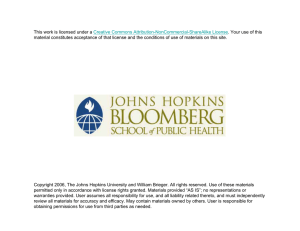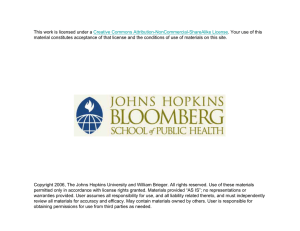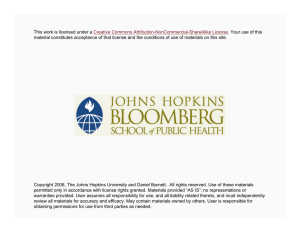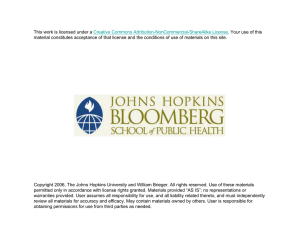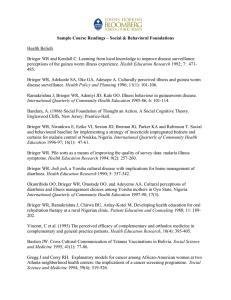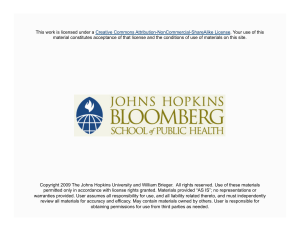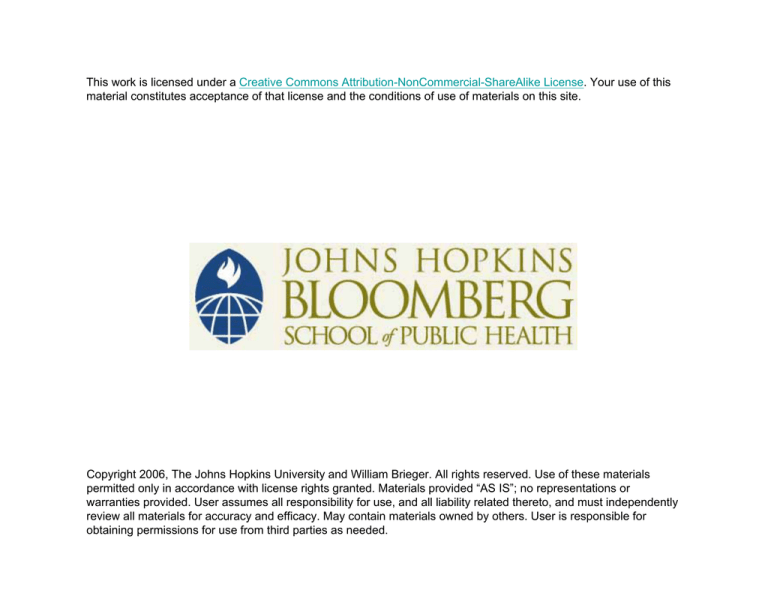
This work is licensed under a Creative Commons Attribution-NonCommercial-ShareAlike License. Your use of this
material constitutes acceptance of that license and the conditions of use of materials on this site.
Copyright 2006, The Johns Hopkins University and William Brieger. All rights reserved. Use of these materials
permitted only in accordance with license rights granted. Materials provided “AS IS”; no representations or
warranties provided. User assumes all responsibility for use, and all liability related thereto, and must independently
review all materials for accuracy and efficacy. May contain materials owned by others. User is responsible for
obtaining permissions for use from third parties as needed.
The Political Economy
Framework
William R. Brieger, MPH, CHES, DrPh
Johns Hopkins University
1
Political Economy Framework
Ù
Ù
Ù
Ù
The political economy
Organizations and institutions
Individuals
Note similarities to Ecological Model
Continued
2
Political Economy Framework
Ù Political economy assumes that
resources are allocated not on the
basis of relative efficiency or merit—
but according to power
Ù The behavior and dynamics of visible
and invisible actors within the health
care sector therefore can only be
understood in terms of their power and
class position in the larger social system
Continued
3
Political Economy Framework
Ù Approaches to health problem analysis
grounded in a political economy
perspective frequently look to the
expanding and contracting of the
economy historically as a means of
contextualizing and helping to explain
the related expansion and contracting
of perceived health and social
problems
4
Issues of Interest
Assumption—Communities Are Not Homogeneous
Ù Class
– Determining what is the basis for
social influence in the community
• Land
• Family history
• Money
• Occupation
Continued
5
Issues of Interest
Assumption—Communities Are Not Homogeneous
Ù Ethnicity
– Different groups co-existing, aware
of each other
– Aware of own position relative to
others
– Power relations, prejudices,
exploitation
Continued
6
Issues of Interest
Assumption—Communities Are Not Homogeneous
Ù Gender
– Roles
– Power
– Economic access
– Decision making
Ù Implies community action approach to
change
7
Source: The Basics
CPHs Held Mock Parliaments
to Address Political Participation Needs
8
Levels of Power
Ù Situational power
– Individual’s ability to make concrete
decisions within existing “rules of
the game”
Ù Organizational power
– Ability to define the “rules of the
game” by elites
Continued
9
Levels of Power
Ù Systemic (structural) power
– The way in which the structure of
the polity and economy favors
certain interests without recourse
to any conscious decisions
– Ability to establish the context of
“the game”
• Issues, approaches, resources
10
Political Economy Issues
Conflict, Hidden Communities, Community Action
Ù Guinea worm
– Neglected disease of neglected
people
Ù AIDS
– “Marginalized” groups in industrial
countries
– “Marginalized” countries affected
11
Discussion of
AIDS Has Often
Been Silenced
12
Political Economy Issues
Conflict, Hidden Communities, Community Action
Ù Alcohol and drug abuse
– Advertising aimed at inner cities
and youth
– Alcoholism is now a “disease”
– Corporations distance themselves
Continued 13
Political Economy Issues
Conflict, Hidden Communities, Community Action
Ù Nutrition
– Political economy model
encourages us to look at how
policy and political decisions affect
health choices
14
Urban transport exemplifies political economy
issues
15
Adolescent Pregnancy and
Reproductive Health
In Rural Transkei
Ù 11% of women were ever-married by
age of 19 years
Ù 43% have had children
Ù For more than a century, black men
were recruited to work in cities
Continued 16
Adolescent Pregnancy and
Reproductive Health
In Rural Transkei
Ù By law, women and children had to
remain in rural areas
Ù Policy promoted a norm of unmarried
women
Ù General acceptance of child-bearing
outside marital unions
17

